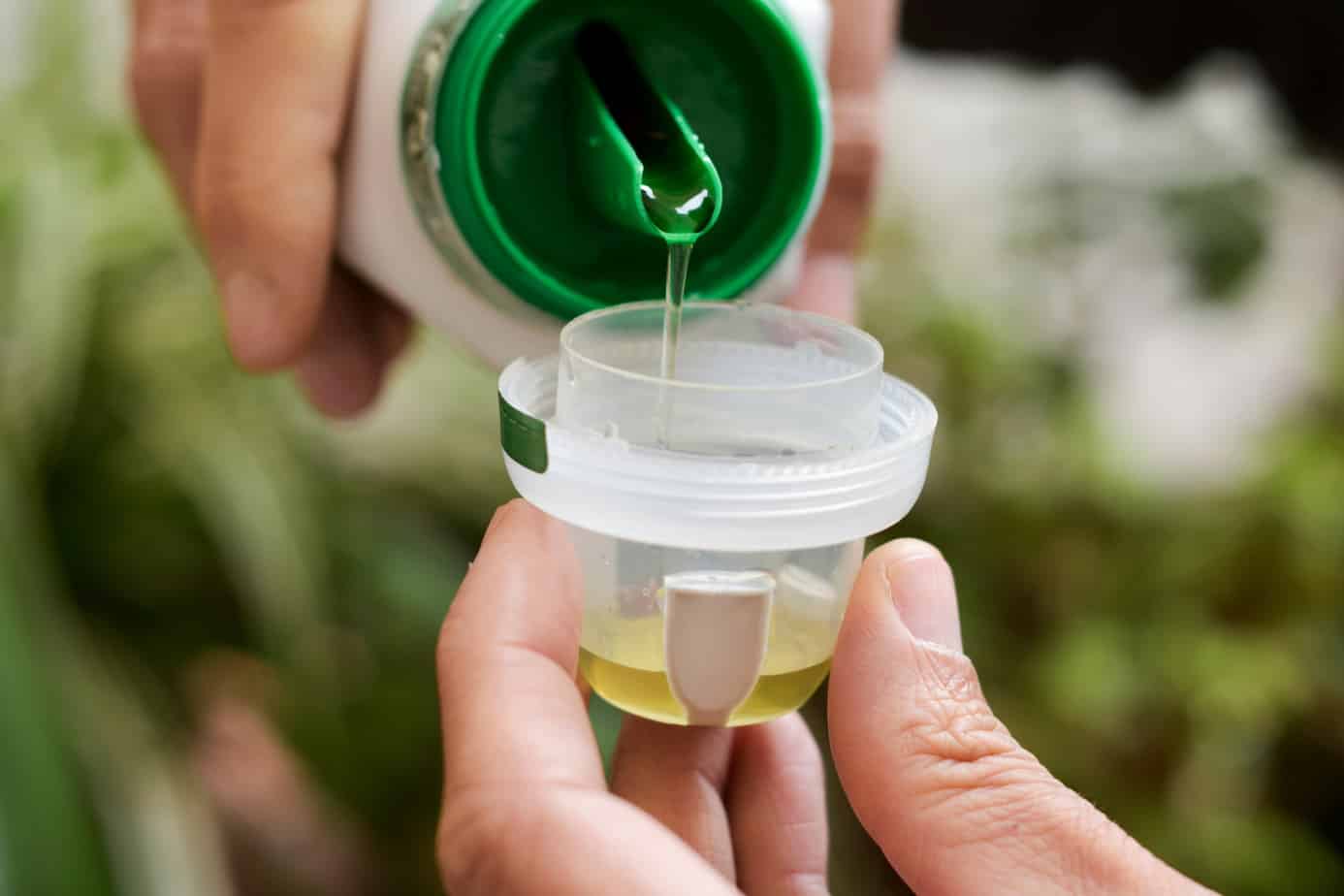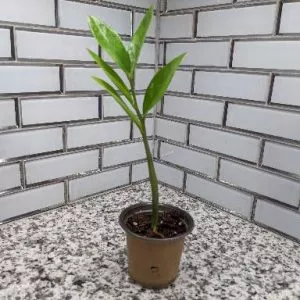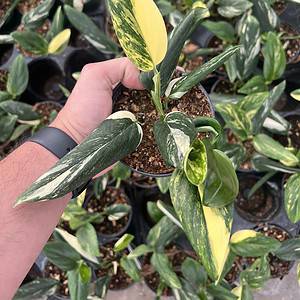No products in the cart.
Table of Contents
The rainbow eucalyptus tree is one remarkable plant with bark that resembles the rainbow. If you traveled to Malaysia or Papua, you would not forget it.
But what if we told you you could have one in your garden or home? You can have the rainbow eucalyptus growing in your garden to view the color palette yourself.
You can even care for this evergreen in the home to transplant to your landscaping later.
What Makes The Eucalyptus Deglupta Special
Interestingly enough, this eucalyptus tree is found native to Australia. But you can find the rainbow-colored in Malaysia and Papua and the northern hemisphere popular in Hawaii. The bark has shades of gray, green, orange, purple, and bright red running along the branches and trunk.
Still, you only see these shades once the bark peels. When you grow the Eucalyptus deglupta outside its tropical setting, the color display is not as pronounced but remains beautiful. Yet, it remains one striking tree that produces small blooms of white flowers after the first two years.
Another interesting fact is that the tree first was mentioned in the mid-18th century, called the Arbor multicolor. Today, botanists call it the rainbow eucalyptus, rainbow gum, and Mindanao gum. Also, it is the only tree harvested for its wood fiber used for making paper.
Rainbow Eucalyptus Care
The rainbow eucalyptus tree is a fast grower, so best not to place it in small yards. The rainbow eucalyptus grows to considerable heights of more than 100 feet. It can also grow three feet every year.
So, if you have space, you will have a tree that provides enough shade in the garden.

Soil
Whether you grow your young rainbow eucalyptus tree as an indoor plant or want to grow it outside, the soil is essential. Remember, the rainbow gum tree is fast-growing.
You can provide your tree with lime-free soil that is acidic using a thin substrate mixed with gravel, coarse sand, or clay. The important thing is that the ground must have drainage at the bottom of the pot or in the environment.
Many gardeners who have the rainbow eucalyptus tree advised growing them in clay-rich soil is the best. It also helps to use some mulch around the root ball to keep it protected.
Lighting Needs
The rainbow tree can thrive in full sun, so it would be best to treat them as outdoor plants. They must also receive some unfiltered light for those multicolor streaks on the bark. The same applies to planting your multi-colored tree inside.
So, when growing indoors, find a sunny location with a huge window. You can place your rainbow eucalyptus trees a foot from your south-facing window, as your plant does not tolerate low light. Planted outside, you can grow your tree in partial to full sun with good air circulation.
But if your tree is young, avoid heavy winds until it matures.
Watering Rainbow Gum Eucalyptus Tree
You have found a perfect spot for your rainbow eucalyptus to grow in direct sunlight with partial shade. Next, you must keep your plant watered, but this tree does not enjoy much lime water. So, where possible, let the rainwater provide it with what it needs.
Alternatively, it helps to water your tree with distilled water grown indoors. You can water your tree every other week, but do not let the root ball dry out completely. Neither must your tree’s root system sit in water as it can lead to root rot.
Hence, please keep checking that the soil is moist but not soggy.
Eucalyptus Deglupta Temperature
The rainbow eucalyptus grows best in warm temperatures and does not thrive in cold temperatures, especially frost. So, if you grow your plant indoors, you have the upper hand to provide it with the temperature it needs. The vital thing is that the temperatures must not drop too low for long inside the home.
We recommend temperatures between 70°F and 85°F to prevent them from getting frostbite.
Humidity Needs for Your Plants
The rainbow eucalyptus grows in high humidity levels. So, your plant needs more attention during the dry season as the entire branches drop and wilt. If you notice yellow leaves starting to curl up, then a mist of water helps revive the foliage.
Fertilizer Rainbow Eucalyptus
As an evergreen, the eucalyptus trees do not need much feeding. Yet, providing your trees with the necessities is essential as they grow fast.

If you planted your tree outside and want it to grow tall, you can provide it with a liquid fertilizer in small amounts in the growing season.
But if you have your plant indoors and provide it nutrients in fertile soil, you need not feed your plant as you do not want it to grow too fast.
Propagating Rainbow Eucalyptus
Great, you want to propagate your tree. That is excellent news. But before you start with stem cuttings, there are some things you need to know. First, you can only reproduce from immature trees.
A study showed that cuttings from seedlings or younger trees could take five years to root well. So, you need to provide your rare plants with a warm yet humid environment for fast results.
The best time to get your cutting is in spring after the new leaves start growing.
Stem Cuttings
- Take plenty of stem cuttings from your healthy growing tree by making clean cuts of up to four inches in length. Each cutting should have at least four nodes on it.
- Remove the bottom leaves and dip that end into a rooting hormone with some fungicide.
- Take a container, fill it with soil, and water it well. Then, place the cutting deep into the ground for the root system to form.
- Place a clear plastic bag over your pot to create a humid environment and water it weekly.
- The roots should start to grow in ten weeks, and once this happens, you can transplant your tree into a larger container.
Germinating Eucalyptus from Seeds
- Take a bottle, fill it with room temperature water, and add 1/2 teaspoon hydrogen peroxide. The hydrogen peroxide helps to break the coating on the seed.
- Place the seed on a paper towel spaced evenly using your fingers.
- Spritz the seeds with the water until the towel is damp, Then fold the towel and place it in a plastic bag. A helpful tip is to write the date on the bag.
- Keep checking on the seeds as they should start germinating after four days.
- If you notice sprouts, you can plant your seedlings in small containers with soil.
- Water your seedlings by checking the soil moisture to keep them wet but not waterlogged.
When your plants reach a taller growth, you can transplant them into bigger pots before planting them outside.
In stock In stock In stock
$15.00
Sold By:
Juan's Grow Garden
Zamioculcas ZZ plant – 3.5 inch pot
Rated 5.00 out of 5 based on 12 customer ratings00
Sold By:
Juan's Grow Garden
Free Shipping
$394.79
Sold By:
BONSAI WORLD LLC
Variegated Hawaiian Umbrella Bonsai Tree Root Over Rock
Only 1 available and it’s in 1 people’s basket
Sold By:
BONSAI WORLD LLC
$70.00
Sold By:
Andy Nursery
$75.00Red Finger Lime Grafted Citrus Tree. 2 Feet Tall.
Only 47 available and it’s in 1 people’s basket
Sold By:
Andy Nursery
Growth Zone
The rainbow eucalyptus grows in a frost-free climate found in the southern parts of the USA. Thus, you can grow these trees in the hardiness zones ten and higher.
Potting and Pruning Rainbow Eucalyptus
These are fast-growing trees, and you might need to transplant them twice a year. The best time to do this is in spring. If you have grown your plants inside and want to plant them outside, it helps to acclimate them first in partial sun to full shade for a couple of weeks.
Also, try to avoid constant heavy winds.
You can start with partial shade and gradually move your rainbow eucalyptus to direct sunlight and keep it watered. For repotting seedlings, you can provide your tree with a bamboo stake tied to the trunk to help it grow straight and support it in heavy winds.
When it comes to pruning your tree, the best time to do this is in late summer to encourage new growth. While there is bleeding sap, the wounds heal fast in warm weather. Also, it depends on how your tree is, and with large wounds, you can apply a dressing to help it heal faster.
Finally, avoid pruning when the humidity level is high, as it can lead to tree diseases. Here are three methods on how you can prune your eucalyptus trees:
Specimen pruning is excellent to help your tree look attractive in landscaping. Yet, do not cut the lower branches up to six feet to do this. Instead, wait for about two seasons of growth as the tree still sheds its old leaves.
Coppicing helps if you grow your rainbow eucalyptus indoors to control the height. It is best to do angle cuts by pruning back 18 inches from the base to remove the side shoots. If your tree has leggy growth, you can cut up to six inches from the ground.
Rainbow Eucalyptus Varieties
Southern Blue Gum – Eucalyptus globulus

The tree is a tall species found globally, growing up to 300 feet high. The plant is drought tolerant and a fast grower with a stately form.
Cider Gum – Eucalyptus gunnii

If you want a cold-hardy eucalyptus, the cider gum tree is what you need. It grows a single trunk up to 120 feet. It also blooms a small white flower with an orange center.
Snow Gum – Eucalyptus Pauciflora

The tree grows in a gnarled manner as the trunk twists and turns to make for a stunning landscape display. The vegetation does well in freezing climates and has white fuzzy flowers.
Rainbow Eucalyptus Diseases & Pests
Critters that can become a problem with your plants are beetles, beetle borers, wasps, psyllids, whiteflies, and sharpshooters attracted by the leaves. To treat these pests, you can use an insecticide or hand soap with eucalyptus oil and water.
It is normal to notice red spots on the leaves as they drop and regrow leaves when young. You will even notice an entire branch dropping and regrowing much foliage when young. Another thing you will see is that old leaves have a reddish coloration.
Other Concerns
Brown hues on leaves: it can result from crown, collar, root, or foot rot. You can use neem oil to prevent overwatering.
Yellowing leaves can happen from high humidity or overwatering. It helps to cut back on watering and move your plant to an area with low humidity.
When your plant dries out, it can result for many reasons. When you snap a twig off, and it is green, it is healthy. But when it snaps fast, there is an issue. This is because your plant lacks nutrients, or you have recently transplanted it and are going through root shock. Another cause is that the greenery is root-bound and cannot take up all the water.
Curling leaves are a sign of stress, and misting the leaves helps. If it does not work, it can also be root stress from repotting or an air conditioner in the home.
Frequently Asked Questions
Rainbow eucalyptus trees are tropical and do not tolerate frost or cold temperatures. They need warm temperatures to thrive.
Yes, young rainbow eucalyptus trees can be grown indoors, provided they receive enough sunlight and humidity.
Rainbow eucalyptus prefers acidic, lime-free soil that is well-draining. Clay-rich soil is also suitable for growing these trees.
Rainbow eucalyptus must be watered regularly, but their roots should not sit in water. It is best to let rainwater provide the tree with moisture where possible.
Rainbow eucalyptus do not need much feeding, but providing them with essential nutrients is necessary as they grow fast. Liquid fertilizers can be added to the soil in small amounts during the growing season.
Yes, you can propagate through stem cuttings, but it is essential to follow the correct procedure.
Whether you want to buy, sell, or simply reach out to other plant enthusiasts, Plantly is the right place to be!
-
$16.00Sold By: Beauties & Beasts
In stock
Cactus – Echinopsis chamaecereus (clumping)
Rated 4.83 out of 5 based on 24 customer ratings00Sold By: Beauties & Beasts -
$14.99Sold By: BubbleBlooms
In stock
Green Velvet, Alocasia Frydek, Micholitziana, 4 inch, live rooted potted rare succulent house plant
Only 99 available and it’s in 1 people’s basketRated 4.81 out of 5 based on 279 customer ratings01Sold By: BubbleBlooms -
Free Shipping$39.95Sold By: CKK PRODUCTS LLC
$49.95In stock
FUYU Persimmon seedlings – large size
Rated 5.00 out of 5 based on 1 customer rating00Sold By: CKK PRODUCTS LLC -
$14.99Sold By: BubbleBlooms
In stock
Blue Columnar Cactus, Pilosocereus pachycladus Cacti, Column cactus, tall blue torch cactus, in 2 inch square pot
Rated 4.81 out of 5 based on 279 customer ratings00Sold By: BubbleBlooms










